|
|
|
Sort Order |
|
|
|
Items / Page
|
|
|
|
|
|
|
| Srl | Item |
| 1 |
ID:
098695
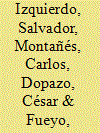

|
|
|
|
|
| Publication |
2010.
|
| Summary/Abstract |
The effect on the cost of electricity from concentrating solar power (CSP) plants of the solar multiple, the capacity factor and the storage capacity is studied. The interplay among these factors can be used to search for a minimal-cost objective that can serve as a technical criterion to guide in the design of economic incentives for CSP plants. The probability-density function of irradiation is used in conjunction with screening models to evaluate the performance characteristics and costs of concentrating solar power plants. Two technologies have been analyzed in this study: parabolic-trough and tower plants. The results provide information to define the optimal operational range as a function of the desired objective. Thus, it is possible to derive a technical criterion for the design of CSP plants which optimizes the solar electricity produced and its generation cost. The methodology is applied to Spain, and the analysis of the results shows that a solar energy production of 37 kWh/m2/year for tower plants and 66 kWh/m2/year for parabolic-trough ones define the approximate optimal working conditions for the mean DNI in Spain.
|
|
|
|
|
|
|
|
|
|
|
|
|
|
|
|
| 2 |
ID:
166706
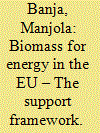

|
|
|
|
|
| Summary/Abstract |
This paper aims to produce a quantitative approach on the overall measures and on public support framework for biomass for energy, based on the EU countries reports under RED and existing literature. The way in which the support for biomass is implemented in the EU energy sector is not similar across EU countries. Feed-in tariffs and feed-in-premiums are still the dominant support schemes for the deployment of bioelectricity, whereas subsidies remain the main support for bioheat. Furthermore, a vast number of EU countries apply mandatory blending quotas for biofuels for transport. The paper shows that biomass for energy has a key role within the EU policy support for RES, in which targets are the main drivers, together with overarching biomass guidelines to anticipate any environmental constraints. Stable support showed the highest effectiveness in the past and remains the key factor for biomass deployment beyond 2020. The renewed targets need to be accompanied by long-term support measures and a commonly shared policy vision. A further harmonization of public bioenergy support towards a single EU cleaner energy market is recommended. This implies four policy actions for all EU countries: in-depth efficiency review, integration with RED-2, compatible sustainability guidelines and local impact assessments.
|
|
|
|
|
|
|
|
|
|
|
|
|
|
|
|
| 3 |
ID:
180858


|
|
|
|
|
| Summary/Abstract |
Renewable portfolio standards (RPS) is an institutional change from Feed-in Tariff (FIT) to government policy and market mechanism. Is it conducive to improve China's social welfare? Given this problem, this paper constructs the social welfare function under the FIT policy and RPS system respectively based on consumer heterogeneity and simulates the social welfare of China under the two schemes on the basis of combining the real economic situation of China. The results show that: (1) Based on China's real economic situation, the implementation of RPS has achieved Pareto improvement and improves China's social welfare. (2) Under the RPS, compared with the actual situation of oligopoly in China's electricity market, competition can improve social welfare better. (3) The effective implementation of RPS depends on the quota level of the government's scientific design. As far as China's current real economic situation is concerned, when the quota is set in the interval (0,0.5], the social welfare under the RPS is always higher than that under the FIT. Therefore, to improve social welfare and promote low-carbon energy transition, China should effectively promote the implementation of RPS, a mandatory institutional change, and strengthen the system construction of RPS.
|
|
|
|
|
|
|
|
|
|
|
|
|
|
|
|
| 4 |
ID:
150443
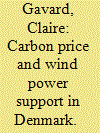

|
|
|
|
|
| Summary/Abstract |
This paper aims at characterizing the conditions of wind power deployment in order to infer a carbon price level that would provide wind power with comparable advantage over fossil fuel technologies as effective wind support policies. The analysis is conducted on Denmark after the electricity market liberalization. Probit and tobit techniques are employed to take account of a potential threshold effect. I find that the level and type of the support policy are the dominant drivers of deployment. A feed-in tariff significantly brings more wind power in than a premium policy. The additional capacity installed monthly increases by more than 1 MW for each additional €/MWh of support. This is compared to the effect of the electricity price, investment cost, interest rate and general economic activity. If the policy is a premium, I find that 23€/MWh of support in addition to electricity price is needed to observe the connection of new turbines to the grid with a 0.5 probability. I convert this support level into a carbon price of 27€/ton if wind power competes with coal, and 48€/t if it competes with gas.
|
|
|
|
|
|
|
|
|
|
|
|
|
|
|
|
| 5 |
ID:
169897


|
|
|
|
|
| Summary/Abstract |
Project finance (PF) is a powerful tool for mobilizing capital for renewable energy (RE) projects but faces challenges in developing countries. This paper examines factors driving the financing method choice between project finance (recourse exclusively to project assets) and corporate finance (recourse to parent company assets), including the feed-in tariff (FIT), using the Philippines as a case study for a developing country. After the RE Law was approved in 2008, RE capacity increased but RE share in energy mix decreased. FIT resulted in increased investments in RE, primarily in solar and wind. Results show that PF incidence is higher for baseload, high-capacity utilization, non-intermittent technologies; non-FIT projects with revenue contracts; and larger projects owned by public companies. Contrary to expectation, PF was less utilized for FIT-eligible RE, and projects owned by private or small investors. PF was utilized primarily by well-capitalized investors, and mostly by power and financial companies. The Philippine FIT's tight deadlines and low technology-specific capacity caps increased revenue uncertainty, resulting in high concentration of project ownership and potential erosion of public support. Given the intrinsic uncertainty of RE and developing countries, policymakers need to design policies to minimize revenue uncertainty, enable PF and broaden the investor base.
|
|
|
|
|
|
|
|
|
|
|
|
|
|
|
|
| 6 |
ID:
090088


|
|
|
|
|
| Publication |
2009.
|
| Summary/Abstract |
Since 1990, effective support schemes for renewable energies have been introduced mainly in European countries. In this article, the authors explain which consequences different general conditions could have on the design and functioning of feed-in laws. Cornerstones for an adjusted feed-in law to the particular general conditions of emerging and developing countries in South America will be drawn, which should give support to the decision-makers for designing an attuned and well-functioning feed-in legislation.
|
|
|
|
|
|
|
|
|
|
|
|
|
|
|
|
| 7 |
ID:
149942


|
|
|
|
|
| Summary/Abstract |
The renewable energy targets put forward by the Chinese government need comprehensive incentive schemes. This paper uses a multi-regional CGE model to evaluate two types of renewable support schemes; a subsidy scheme like a feed-in tariff (FIT) with a direct price impact for final consumers and a subsidy scheme without any price impact. We assess the CO2 consequences of both approaches, as well as their impact on economic activity in terms of GDP, industrial structure, electricity generation structure, and regional final demand elasticities of electricity. We find that a support scheme with price impact is much more effective in reducing CO2 emissions while the difference in GDP between the two policies is small. We estimate that the price implications of the support scheme allow for an additional emissions reduction of 113 Mt CO2—or 0.07% of total emissions—in China during 2020–2035. The support scheme with a price impact does not lead to a negative impact on the Chinese economy although there are significant differences among regions. In addition, while the whole country faces an approximately unitary electricity elasticity demand, we find significant differences in electricity demand elasticities among Chinese regions.
|
|
|
|
|
|
|
|
|
|
|
|
|
|
|
|
| 8 |
ID:
186452
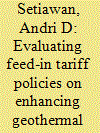

|
|
|
|
|
| Summary/Abstract |
Geothermal is vital for sustainably meeting Indonesia's energy demand, given its estimated massive reserves potential equivalent to 24 GW of electricity. The Indonesian government has set geothermal contributions to the national energy mix at 7,241.5 MW by 2025 and 17,546 MW by 2050, despite harnessing such vast potential needing significant investment. To that goal, the government established a feed-in tariff (FIT) mechanism to encourage private sector investment in geothermal development. However, FIT has undergone significant alterations in a short period. Moreover, various complicating factors—bureaucracy, social, and technical—exist alongside FIT implementation. Therefore, the extent that FIT can effectively enhance geothermal development in Indonesia should be challenged with further investigation. This study explores the efficacy of FIT policies for geothermal electricity by comparing the performance of several FIT schemes in terms of their impact on the government's target achievement. This study combines the policy analysis framework with system dynamics modeling to understand the dynamic interaction of FIT policy and other important components in geothermal development. The findings show that modest bureaucracy and public support are required. Furthermore, to enhance geothermal development more effectively, FIT should be at least 11 cents US$/kWh and accompanied by technical breakthroughs and government-funded exploration activities.
|
|
|
|
|
|
|
|
|
|
|
|
|
|
|
|
| 9 |
ID:
115646


|
|
|
|
|
| Publication |
2012.
|
| Summary/Abstract |
Feed-in tariff program is an incentive plan that provides investors with a set payment for electricity generated from renewable energy sources that is fed into the power grid. As of today, FIT is being used by over 75 jurisdictions around the world and offers a number of design options to achieve policy goals. The objective of this paper is to propose a quantitative model, by which a specific FIT program can be evaluated and hence optimized. We focus on payoff structure, which has a direct impact on the net present value of the investment, and other parameters relevant to investor reaction and electricity prices. We combine cost modeling, option valuation, and consumer choice so as to simulate the performance of a FIT program of interest in various scenarios. The model is used to define an optimization problem from a policy maker's perspective, who wants to increase the contribution of renewable energy to the overall energy supply, while keeping the total burden on ratepayers under control. Numerical studies shed light on the interactions among design options, program parameters, and the performance of a FIT program.
|
|
|
|
|
|
|
|
|
|
|
|
|
|
|
|
| 10 |
ID:
192728


|
|
|
|
|
| Summary/Abstract |
This paper theoretically establishes a solar sheep game model under three cases to capture the friction among the stockholders including the government, PV investors, and shepherds. Nash equilibrium has been revealed for analyzing the impact of different policies on the benefits of each player. The results show that the implementation of the feed-in tariff (FIT) policy can maximize the government’s revenue. However, when the government focuses on promoting poverty alleviation for shepherds, the sheep farming (SF) subsidy policy is more efficient than FIT if the positive effect of the PV panel on sheep raising is not enough. Besides, dynamic system models are established either to study the bounded rationality behavior during the decision process in the long run. Thresholds regarding speed of decision adjusting for each player are found. Results also show the system will lose stability if players adjust their decisions too frequently. Based on data from Talatan and Cascadilla, numerical analysis has been applied to illustrate the managerial implications from the proposed model.
|
|
|
|
|
|
|
|
|
|
|
|
|
|
|
|
| 11 |
ID:
166967


|
|
|
|
|
| Summary/Abstract |
In the context of the German energy transition, the financial burdens associated with subsidies for renewable energies have increased substantially in recent years. These costs are passed on to consumers in the form of the EEG levy as a component of the electricity price. However, some households benefit from owning photovoltaic (PV) systems because they receive the corresponding feed-in tariffs. In order to investigate how the benefits (and burdens) of this subsidization scheme are distributed, we use micro-data from SOEP for private households during the period of 2010–2017, and we employ three different inequality metrics – the Gini coefficient, the Theil index and the Atkinson index. We conclude that subsidy costs are almost evenly distributed among the population and are therefore regressive. At the same time, feed-in tariffs are increasingly flowing into higher-income households because PV systems are more prevalent in these households. We estimate the overall impact of this subsidization scheme on several measures of (income) inequality at 1.0–2.4%, most of which is due to the EEG levy. We also find regional distortions in favor of the South and especially at the expense of the East.
|
|
|
|
|
|
|
|
|
|
|
|
|
|
|
|
| 12 |
ID:
150747


|
|
|
|
|
| Summary/Abstract |
The article employs qualitative methods in contextualizing and conceptualizing the hybrid renewable energy support policy. It claims that hybrid policies may combine distinct mechanisms to drive desirable objectives better than traditional policies. A policy cycle helps to frame the United Kingdom's Contracts for Difference and Capacity Market (CFD & CM) scheme as a case study. The CFD & CM policy emerged to address environmental and energy challenges through the deployment of renewable energy (RE) in a low-carbon economy, employing liberalization: Environmental protection is foremost in this scheme. The policy combines and improves on the elements of feed-in tariff (FIT) and quota obligation (QO), and strives to solve the problems of these traditional policies. It addresses regulatory uncertainty under FIT by employing private law mechanics to guarantee above-loss reward for low carbon generation, and addresses market uncertainty under QO by incentivizing the capacity to supply future low carbon energy based on projected demand, hence creating a predictable and stable market. It also accommodates other important commitments. Overall, the CFD & CM scheme is a hybrid policy that engages the energy market mainly for advancing the end goal of environmental protection. To thrive however, it needs to meet private sector interests substantially.
|
|
|
|
|
|
|
|
|
|
|
|
|
|
|
|
| 13 |
ID:
177467


|
|
|
|
|
| Summary/Abstract |
Feed-in tariff (FIT) is a broadly used policy instrument around the world, in which the payment level is always designed to decline gradually in order to track and encourage technological improvement in renewable energy. However, the potential adverse effects of tariff degression on renewable energy research and development (R&D) investment have not been sufficiently addressed. In this paper, we explore the impact of FIT payment degression on renewable energy R&D investment and analyze the efficient FIT payment structure for R&D investment. We form a modeling framework that captures the dynamics of FIT payment levels and the inventor's strategic reactions to tariff changes. In this framework, we model the inventor's optimal R&D investment decisions based on the canonical real option approach and simulate the impact of FIT payment degression on R&D investment and the efficient FIT payment structure under different R&D characteristics using the case of the solar photovoltaic (PV) industry. Our results emphasize the adverse effect of tariff degression on the commercial value of new renewable technology and hence the inventor's incentive in R&D investment, especially when facing more technical uncertainty and financial constraints. Our model could help policymakers to design an efficient FIT payment structure through which the cost of the FIT program is restricted to a minimum level but without influencing the inventor's R&D investment decisions.
|
|
|
|
|
|
|
|
|
|
|
|
|
|
|
|
| 14 |
ID:
133148


|
|
|
|
|
| Publication |
2014.
|
| Summary/Abstract |
Photovoltaic (PV) has the highest cost reduction potential among all renewable energy sources (RES). To overcome institutional barriers, developing the technology, and creating an initial market, policies are needed. Comparative case studies of Japan and German PV sector from 1990 to 2011 were developed. Japan dominated the PV industry during 1994-2004, PV market increased to 290 MW in 2005. After 2005 Japan×s PV market decreased. German PV market increased from 44 MW in 2000 to 7.5 GW in 2011. The reason behind Japanese PV market decline was the unaligned energy policy and termination of incentives. This paper discusses about successful policy implementation and the impact of policy for the diffusion of PV technology. The analysis section of this paper shows how much the PV technology has been diffused during the period of 1990-2011 and finally what will make the transformation process successful.
|
|
|
|
|
|
|
|
|
|
|
|
|
|
|
|
| 15 |
ID:
119804


|
|
|
|
|
| Publication |
2013.
|
| Summary/Abstract |
The Law 3468/2006 provided for first time in 2006 appealing feed-in tariff (FiT) incentives for photovoltaics (PVs) in Greece. The response of the national market was immediate in less than 2 years' time. Two subsequent laws formed an even more attractive investment and licensing context both for field and building installations, by introducing additional guarantees and improved grid-connection procedures. However, the unexpectedly large amount of applications submitted until 2011, with aggregate PV capacities which exceeded the national target for 2020 caused continuously tremendous delays in grid-connection processes. Undoubtedly, the effectiveness of this legislative framework cannot be judged solely by the response of prospective investors. In that sense, main objectives of this paper are to present and discuss about the effective provisions as well as the major weaknesses of the FiT legislation in Greece since 2006, associated mainly with its attractiveness to investors and its cost-effectiveness towards preserving and supporting the Greek PV market. The paper concludes with a technoeconomic assessment, which evaluates PV projects' viability, especially those ones whose provision of grid-connection offer was postponed several times.
|
|
|
|
|
|
|
|
|
|
|
|
|
|
|
|
| 16 |
ID:
175261


|
|
|
|
|
| Summary/Abstract |
The Chinese government plans to adopt a low or no subsidy policy mechanism on renewable energy power development in the future. To achieve a balance between reducing financial burden on the government and ensuring profitability of investors as well as to account for the regional differences in China, a novel regional wind power grid feed-in tariff benchmark price mechanism by Net Present Value (NPV) method and Real Option (RO) method is proposed in this paper. The results voice support on the appropriateness of gradually decreasing the wind feed-in tariff (FIT) benchmark price to as low as the coal-fired FIT. The proposed FIT price level is presented as a price range on the basis of a guaranteed Internal Rate of Return (IRR) falls in between 8% to 15% for wind power investors. The results indicate that the current FIT price should be readjusted and redistributed. Although the FIT price in Central and South China grids is recommended to be relatively high, the NPV of wind farm project value in six regional grids are at the same level.
|
|
|
|
|
|
|
|
|
|
|
|
|
|
|
|
| 17 |
ID:
092803


|
|
|
|
|
| Publication |
2009.
|
| Summary/Abstract |
The European Commission has adopted Directive 2004/8/EC on the promotion of cogeneration, which the EU Member States, as well as candidates including Croatia, were obliged to accept. Among other terms and conditions, the Directive requires certain support mechanisms, such as feed-in tariff prices and premiums added to market electricity prices. In this paper, the cost effectiveness of selling electricity at the feed-in tariff prices in the selected EU Member States is compared to selling it on the European electricity market, with or without premiums. The results of this comparison will indicate whether correction of the Croatian feed-in tariff price to a higher value would be justified. The cost effectiveness ratio of a cogeneration unit upgraded with mean reverting and jump diffusion processes is used for comparison. At the end of this paper, a method is suggested for the correction of feed-in tariff prices, with examples of corrected prices for the years 2008 and 2009. Such corrections have been proven to be justified and are compared to the feed-in tariff prices in most of the selected EU Member States.
|
|
|
|
|
|
|
|
|
|
|
|
|
|
|
|
| 18 |
ID:
150059


|
|
|
|
|
| Summary/Abstract |
The feed-in tariff policy is widely used to promote the development of renewable energy. China also adopts feed-in tariff policy to attract greater investment in solar photovoltaic power generation. This study employs real options method to assess the optimal levels of feed-in tariffs in 30 provinces of China. The uncertainties in CO2 price and investment cost are considered. A method that integrates the backward dynamic programming algorithm and Least-Squares Monte Carlo method is used to solve the model. The results demonstrate that the feed-in tariffs of 30 provinces range from 0.68 RMB/kWh to 1.71 RMB/kWh, and the average level is 1.01 RMB/kWh. On this basis, we find that the levels of sub-regional feed-in tariff announced in 2013 are no longer appropriate and should be adjusted as soon as possible. We have also identified the implications of technological progress and carbon emission trading schemes, as well as the importance of strengthening electricity transmission. It has been suggested that the Chinese government takes diverse measures, including increasing research and development investment, establishing and improving a nationwide carbon emission trading scheme and accelerating the construction of electricity-transmission infrastructure, to reduce the required feed-in tariff and promote the development of solar photovoltaic power generation.
|
|
|
|
|
|
|
|
|
|
|
|
|
|
|
|
| 19 |
ID:
162286
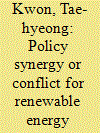

|
|
|
|
|
| Summary/Abstract |
Governments provide various incentives for the production of electricity from renewable energy sources (RES-E). South Korea has promoted the use of such electricity through various programmes, such as Feed-in Tariff from 2002 to 2011, and Renewable Portfolio Standard (RPS) since 2012. The RPS appears to have been particularly effective in stimulating the use of RES-E. However, there remain several issues regarding the current RPS’ policy design. This study examines South Korea's RPS by focusing on two issues. The first issue is the regulation of technology competition under the RPS; and the second issue is risk mitigation, which is generally known as a weakness of the RPS policy.
|
|
|
|
|
|
|
|
|
|
|
|
|
|
|
|
| 20 |
ID:
180848


|
|
|
|
|
| Summary/Abstract |
We analyze how tariff design incentivizes households to invest in residential photovoltaic and battery storage systems, and explore selected electricity sector effects. To this end, we develop an open-source electricity sector model that explicitly features prosumage agents and apply it to German 2030 scenarios. Results show that lower feed-in tariffs substantially reduce investments in residential photovoltaics, yet optimal battery sizing and self-generation are relatively robust. With increasing fixed parts of retail tariffs and, accordingly, lower volumetric retail rates for grid consumption, households have lower incentives for self-consumption. As a consequence, optimal battery capacities and self-generation are smaller, and households contribute more to non-energy power sector costs. A cap on hourly feed-in by households may relieve distribution grid stress without compromising PV expansion or prosumage models for households. When choosing tariff designs, policy makers should not aim to (dis-)incentivize prosumage as such, but balance effects on renewable capacity expansion and system cost contribution.
|
|
|
|
|
|
|
|
|
|
|
|
|
|
|
|
|
|
|
|
|